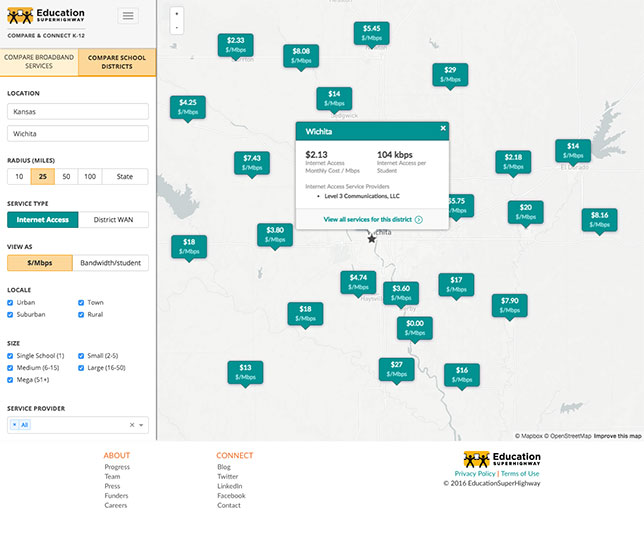Free Service Lets Districts Compare Their Bandwidth and Costs with Other Districts
- By Dian Schaffhauser
- 11/15/16
Compared to 10 other comparably sized school districts in California, the one in Nevada City pays more for its Internet and gets less. While the three-school district pays $175 per month for 1.5 megabits per second (Mbps), Maxwell Unified in Colusa pays $149 for 500 Mbps. El Centro Elementary pays $54 for 12 Mbps. On the wide area network (WAN) side, the district pays $1,379 for 100 Mbps of bandwidth compared to $405 for 16 gigabits per second (Gbps) at Chico Unified and $1,232 for Sonoma Valley Unified's 3 Gbps.
Those comparisons were generated through a new online tool introduced by EducationSuperHighway (ESH). Compare & Connect K-12 is intended to provide price transparency to help schools and districts get more bandwidth for their broadband budgets. The organization behind the tool is a non-profit that focuses on upgrading the Internet access available in public schools. Its work is funded by Mark Zuckerberg's Startup: Education and the Bill & Melinda Gates Foundation.

Compare & Connect K-12 uses 2015 and 2016 data pulled from the Federal Communications Commission's E-rate program application data coupled with a painstaking confirmation process that involved direct communication between the organization's team of analysts, data experts and developers and 5,500 E-rate applicants, district leaders, technology directors, state partners and E-rate consultants. The cost information doesn't reflect E-rate discounts, since they're intended to show the total cost of providing bandwidth for educational purposes, not what the school district pays. In cases where state or school district people identified broadband services not applied for through E-rate, those services were added to the dataset "to provide a holistic view of the network architecture for a given school district."
"We built Compare & Connect K-12 to create transparency around the bandwidth school districts buy," a FAQ on the website explained. "We believe data transparency is critical for two reasons: 1) It creates informed buyers at the state and school district level who, as a result of transparency, can negotiate more effectively to increase bandwidth for their students; and 2) It helps track progress towards bandwidth targets that will enable all students to take advantage of digital learning."
Comparisons on the site can be done across school districts or by broadband services. Results can be filtered by type of service, speed, type of connection, state and service provider. The comparison tool also provides a visual image showing how much bandwidth the district can expect to need in the future compared to what it currently has. That calculation is based on the FCC's 2018 1 Mbps-per-student bandwidth recommendation.
ESH already claims victory in its efforts to help schools negotiate better deals. For example, Great Falls Public Schools in Montana used the beta version of the tool to compare the price it was paying for its bandwidth against that of neighboring school districts. Armed with that information, the district was able to negotiate within its long-term contract with its existing provider and get 330 percent more bandwidth for an additional 8 percent increase in monthly cost.
"Compare & Connect K-12 gave us unprecedented insight into other school districts' cost to bandwidth ratios, which helped us discover that we could get much more bandwidth at nearly the same cost," said Tom Hering, the district's director of IT, in a press release. "We leveraged this data to upgrade our bandwidth to 1,000 Mbps, enabling more digital learning opportunities in the classroom to better prepare our students for today's increasingly technology-centric world."
The organization also expects service providers to use the program to identify potential customers for their broadband upgrade services.
"Armed with the knowledge of the services that other school districts can obtain with similar budgets, we've seen technology directors significantly increase their bandwidth, usually without an increase in cost, enabling school districts to make the most of their budgets," noted Evan Marwell, CEO of ESH. "Every student deserves equal access to reliable high-speed Internet access for digital learning, and Compare & Connect K-12 is helping school districts get one step closer to achieving that goal."
Compare & Connect K-12 is available online with or without registration at compareandconnectk12.org.
About the Author
Dian Schaffhauser is a former senior contributing editor for 1105 Media's education publications THE Journal, Campus Technology and Spaces4Learning.